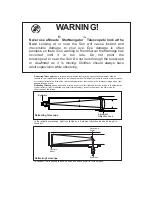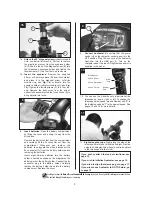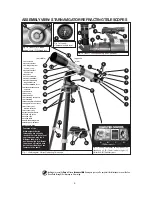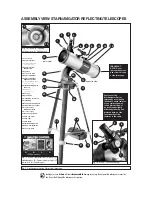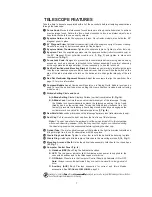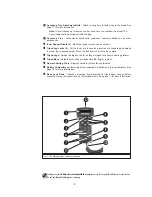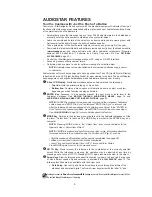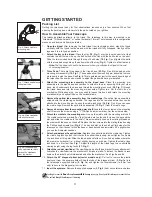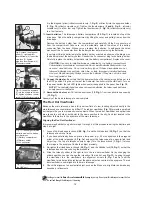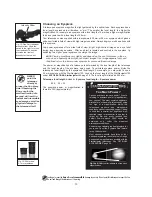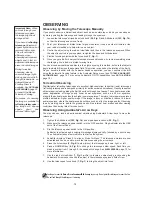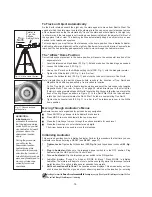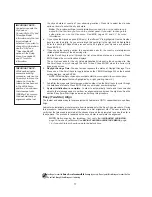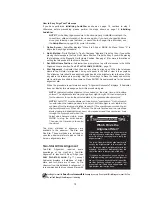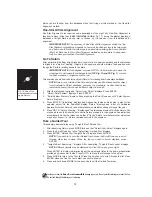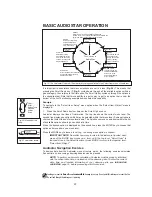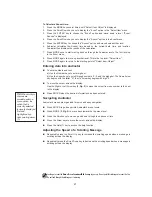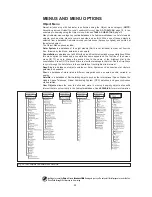
7
Looking at or near the
Sun
will cause
irreversable
damage to your eye. Do not point this telescope at or near the Sun.
Do not look through the telescope as it is moving.
Take the time to become acquainted with all of these controls before attempting observations
through the telescope.
쐃
Focus Knob: Moves the telescope’s focus drawtube in a finely-controlled motion to achieve
precise image focus. Rotate the focus knob clockwise to focus on distant objects, and
counterclockwise to focus on nearby objects.
���
Eyepiece Holder: Holds the eyepiece in place. On refractor models, also holds the 90°
diagonal prism in place.
���
90° Diagonal Prism (
refractor models only): Holds the eyepiece upright for easy viewing.
Results in an upright, but reversed viewing of land objects.
���
Eyepiece Holder Thumbscrew: Tightens the eyepiece in place. Tighten to a firm feel only.
���
Eyepiece: Place the supplied eyepiece into the eyepiece holder (
reflector models only) or
the 90° Diagonal Prism (
refractor models only, 3, Fig. 1) and tighten in place with
thumbscrew (4, Fig.1).
���
Focus Lock Knob: Designed to prevent the focuser drawtube from moving when a heavy
accessory, such as a camera, is attached to the focuser assembly. For normal observing
with an eyepiece and diagonal prism, it is not necessary to use the lock knob.
���
Red Dot Viewfinder and Mounting Bracket: Provides an easier way to initially sight objects
than the main telescope eyepiece which has a narrower field of view. Slide the switch on the
side of the red dot viewfinder to turn on the device and to change the intensity of the red
dot.
���
Red Dot Viewfinder Alignment Screws: Adjust these screws to align the viewfinder. See
page 12 for more information.
���
Compass/Bubble Level: Compass will assist you in finding North. Bubble level can be
used to level the optical tube when setting the Home Position (included with refractng
models only.)
쐅
Altitude Setting Circle and Lock
A) Altitude Setting Circle: Displays Altitude (vertical) coordinates (E, Fig. Ib).
B) Altitude Lock: Controls the manual vertical movement of the telescope. Turning
the Altitude lock counterclockwise unlocks the telescope enabling it to be freely
tilted by hand on the vertical axis. Turning the Altitude lock clockwise (to a firm
feel only) prevents the telescope from being moved manually and engages the
vertical motor drive clutch for Audiostar operation (F, Fig. Ib).
쐈
Dew Shield: Reduces dew formation on the telescope's primary lens (refractor models only).
쐉
Dust Cap: Pull to remove the dust cap from the front lens of the telescope.
Note: The dust cap should be replaced and the power turned off to the telescope
after each observing session. Verify that any dew that might have collected during
the observing session has evaporated before replacing the dust cap.
씈
Optical Tube: The main optical component that gathers the light from distant objects and
brings this light to a focus for observation with the eyepiece.
씉
Cradle Ring Lock Knob: Tighten to a firm feel to hold the optical tube securely in place.
씊
Cradle Ring: Holds optical tube in place. Attaches to the mounting arm shaft (16, Fig. 1).
씋
Mounting Arm and Shaft: Holds the optical tube assembly. Attaches to the tripod base
(23, Fig. 1).
씌
Computer Control Panel (Fig. Ic)
A. Handbox (HBX) Port: Plug the Audiostar handbox.
B. LED: The red power indicator light illuminates when power is supplied to the
connected handbox and to the telescope’s motor drive.
C. ON Switch: Press to turn the Computer Control Panel and Audiostar ON or OFF.
Note: Always remove the batteries if they are not to be used for a long period of
time.
D. Auxiliary (AUX) Port: Provides connection for current and future Meade
accessories. See
OPTIONAL ACCESSORIES
, page 32.
TELESCOPE FEATURES
Summary of Contents for starnavigator ng series
Page 8: ...This page folds out...


